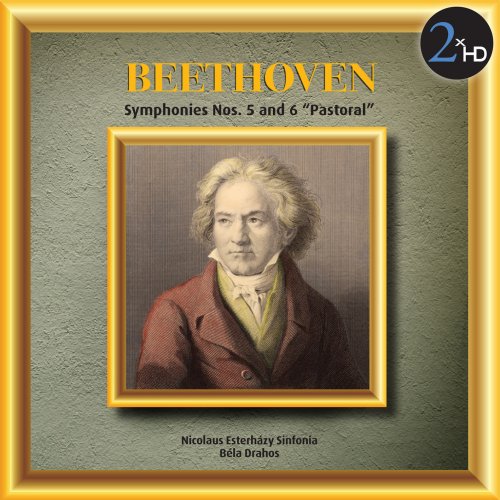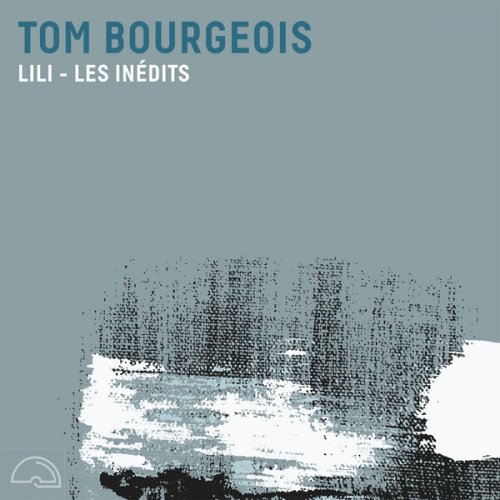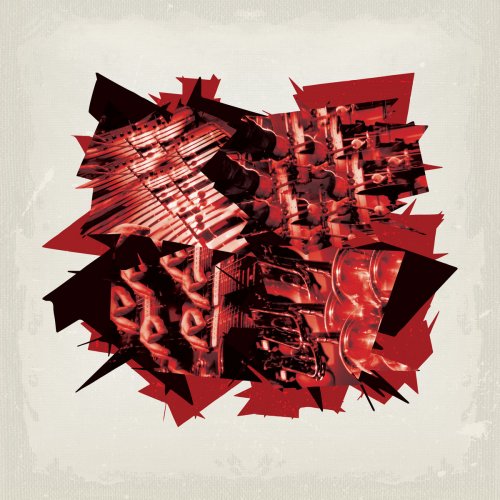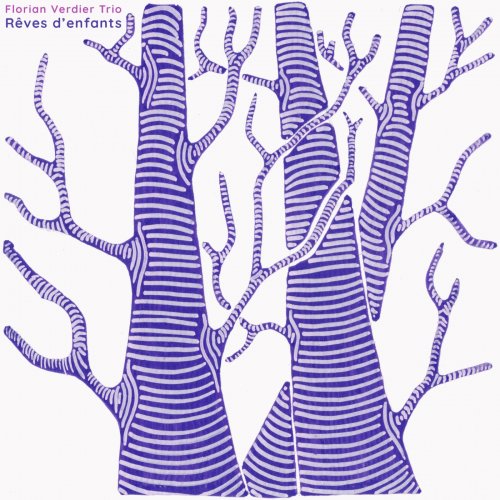Nicolaus Esterhazy Sinfonia & Bela Drahos - Beethoven: Symphonies Nos. 5 & 6 Pastoral (1997/2015) [Hi-Res]

Artist: Nicolaus Esterhazy Sinfonia & Bela Drahos
Title: Beethoven: Symphonies Nos. 5 & 6 Pastoral
Year Of Release: 2015
Label: 2xHD - Ondine
Genre: Classical
Quality: 24bit-44.1kHz FLAC (tracks+d.booklet)
Total Time: 01:17:44
Total Size: 711 MB
WebSite: Album Preview
Tracklist:Title: Beethoven: Symphonies Nos. 5 & 6 Pastoral
Year Of Release: 2015
Label: 2xHD - Ondine
Genre: Classical
Quality: 24bit-44.1kHz FLAC (tracks+d.booklet)
Total Time: 01:17:44
Total Size: 711 MB
WebSite: Album Preview
Symphony No. 5 in C Minor, Op. 67
1. I. Allegro con brio07:18
2. II. Andante con moto09:21
3. III. Allegro08:33
4. IV. Allegro10:36
Symphony No. 6 in F Major, Op. 68 “Pastoral”:
5. I. Awakening of Cheerful Feelings Upon Arrival in the Country: Allegro ma non troppo 11:10
6. II. Scene by the Brook: Andante molto mosso 12:04
7. III. Merry Gathering of Country Folk: Allegro 04:59
8. IV. Thunderstorm: Allegro 03:54
9. V. Shepherd's Song: Happy and Thankful Feelings after the Storm: Allegretto 09:53
Beethoven wrote nine symphonies, the first heralding the new century, in 1800, and the last completed in 1824. Although he made few changes to the composition of the orchestra itself, adding, when occasion demanded, one or two instruments more normally found in the opera-house, he expanded vastly the tradition al form, developed in the time of Haydn and Mozart, reflecting the personal and political struggles of a period of immense change and turbulence. To his contemporaries he seemed an inimitable original, but to a number of his successors he seemed to have expanded the symphony to an intimidating extent.
Beethoven's Symphony in C minor, Opus 67, is a work that has enjoyed enormous popularity, not least for its patriotic associations that accord well with the period of its composition and have proved to suit the sensibilities of later generations. For some the work has become known as Fate, as the result of an alleged remark of the composer, reported by the unreliable Schindler, on the opening of the first movement – Thus Fate knocks at the door. It has been left for others to point out that there is plenty of evidence for similar knocking at doors in other compositions by Beethoven, the initial rhythmic figure being one that he found to his purpose on other occasions.
Beethoven composed music relatively slowly and carefully, and the early sketches for the C minor Symphony are found in notebooks of 1804, the period of the Eroica Symphony. The work was completed in 1808 and dedicated to Count Razumovsky, Prince Lichnowsky's brother-in-law, the Tsar's representative in Vienna and a patron of great munificence, while his money lasted, and to Prince Lobkowitz. It received its first performance at a concert on 22nd December, 1808. The taxing programme, that resulted in near disaster in the final Choral Fantasia, included the Pastoral Symphony and the Fourth Piano Concerto, as well as a number of items for soloists and chorus.
It seems that the Fifth Symphony was at first intended, like the Fourth, for Count Franz von Oppersdorff, from whom the composer certainly received some payment. By September of the year of its completion, however, Beethoven had sold it to the publishers Breitkopf and Härtel. In orchestration the Fifth Symphony shows innovations in its inclusion of the piccolo, the double bassoon and three trombones in the final movement.
The sixth of Beethoven's nine symphonies, the Pastoral, was first performed at a concert in Vienna in December 1808. The occasion was an important one for the composer, since it was likely to prove the only significant source of income for him that year. In preparation for the event he had put aside work on his projected opera Macbeth and on the alternative text of Bradamante, both supplied by Heinrich von Collin, and assembled a programme of phenomenal length. The works played included the Fifth Symphony, the Fourth Piano Concerto, a piano fantasia, items for soloists and chorus and, in conclusion, a Fantasia for the Pianoforte which ends with the gradual entrance of the entire orchestra and the introduction of the choruses as a finale, the Choral Fantasia.
Predictably the concert was an embarrassment to Beethoven's friends, compelled to sit for four hours in the bitterly cold Theater-an-der-Wien. As one otherwise sympathetic observer reported, it proved possible to have too much of a good thing, and still more of a loud. The concert was under-rehearsed, and Beethoven had met considerable opposition from members of the orchestra. In the Choral Fantasia instructions about repeats had been misunderstood, so that the work had to be started again, and Beethoven intervened with audible comments on mistakes. Nevertheless the Sixth Symphony, which happily opened the concert, was well enough received, in spite of its unusual length.
The advertisement for Beethoven's December concert billed the Pastoral Symphony as A Recollection of Country Life, to be described by the composer, in a careful attempt to dispel any suspicion that he had written a crude imitation of nature, as more an expression of feeling than tone-painting. In some ways the work may be seen as a conclusion and summary of a tradition of music inspired by the country, although the Wordsworthian suggestion of emotion recollected in tranquillity is very much of its period.
Nicolaus Esterhazy Sinfonia
Bela Drahos, conductor
Digitally remastered
Beethoven's Symphony in C minor, Opus 67, is a work that has enjoyed enormous popularity, not least for its patriotic associations that accord well with the period of its composition and have proved to suit the sensibilities of later generations. For some the work has become known as Fate, as the result of an alleged remark of the composer, reported by the unreliable Schindler, on the opening of the first movement – Thus Fate knocks at the door. It has been left for others to point out that there is plenty of evidence for similar knocking at doors in other compositions by Beethoven, the initial rhythmic figure being one that he found to his purpose on other occasions.
Beethoven composed music relatively slowly and carefully, and the early sketches for the C minor Symphony are found in notebooks of 1804, the period of the Eroica Symphony. The work was completed in 1808 and dedicated to Count Razumovsky, Prince Lichnowsky's brother-in-law, the Tsar's representative in Vienna and a patron of great munificence, while his money lasted, and to Prince Lobkowitz. It received its first performance at a concert on 22nd December, 1808. The taxing programme, that resulted in near disaster in the final Choral Fantasia, included the Pastoral Symphony and the Fourth Piano Concerto, as well as a number of items for soloists and chorus.
It seems that the Fifth Symphony was at first intended, like the Fourth, for Count Franz von Oppersdorff, from whom the composer certainly received some payment. By September of the year of its completion, however, Beethoven had sold it to the publishers Breitkopf and Härtel. In orchestration the Fifth Symphony shows innovations in its inclusion of the piccolo, the double bassoon and three trombones in the final movement.
The sixth of Beethoven's nine symphonies, the Pastoral, was first performed at a concert in Vienna in December 1808. The occasion was an important one for the composer, since it was likely to prove the only significant source of income for him that year. In preparation for the event he had put aside work on his projected opera Macbeth and on the alternative text of Bradamante, both supplied by Heinrich von Collin, and assembled a programme of phenomenal length. The works played included the Fifth Symphony, the Fourth Piano Concerto, a piano fantasia, items for soloists and chorus and, in conclusion, a Fantasia for the Pianoforte which ends with the gradual entrance of the entire orchestra and the introduction of the choruses as a finale, the Choral Fantasia.
Predictably the concert was an embarrassment to Beethoven's friends, compelled to sit for four hours in the bitterly cold Theater-an-der-Wien. As one otherwise sympathetic observer reported, it proved possible to have too much of a good thing, and still more of a loud. The concert was under-rehearsed, and Beethoven had met considerable opposition from members of the orchestra. In the Choral Fantasia instructions about repeats had been misunderstood, so that the work had to be started again, and Beethoven intervened with audible comments on mistakes. Nevertheless the Sixth Symphony, which happily opened the concert, was well enough received, in spite of its unusual length.
The advertisement for Beethoven's December concert billed the Pastoral Symphony as A Recollection of Country Life, to be described by the composer, in a careful attempt to dispel any suspicion that he had written a crude imitation of nature, as more an expression of feeling than tone-painting. In some ways the work may be seen as a conclusion and summary of a tradition of music inspired by the country, although the Wordsworthian suggestion of emotion recollected in tranquillity is very much of its period.
Nicolaus Esterhazy Sinfonia
Bela Drahos, conductor
Digitally remastered
Download Link Isra.Cloud>>>
Bela Drahos - Beethoven.rar - 711.5 MB
Bela Drahos - Beethoven.rar - 711.5 MB







![Frode Kjekstad - Stars Aligned (2026) [Hi-Res] Frode Kjekstad - Stars Aligned (2026) [Hi-Res]](https://img.israbox.com/img/2026-01/08/n12580el2kaqvo9f0inrj0po7.jpg)
